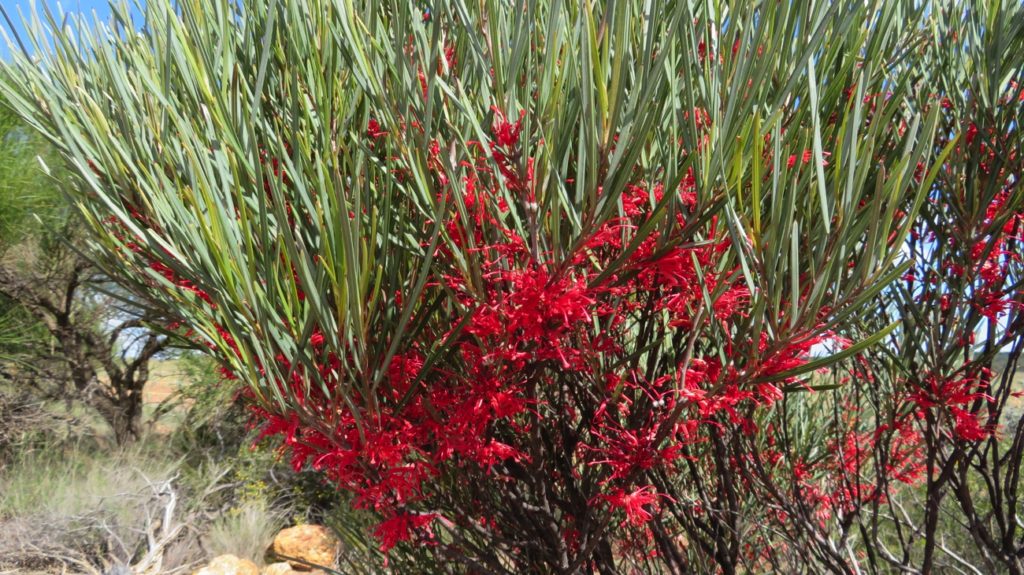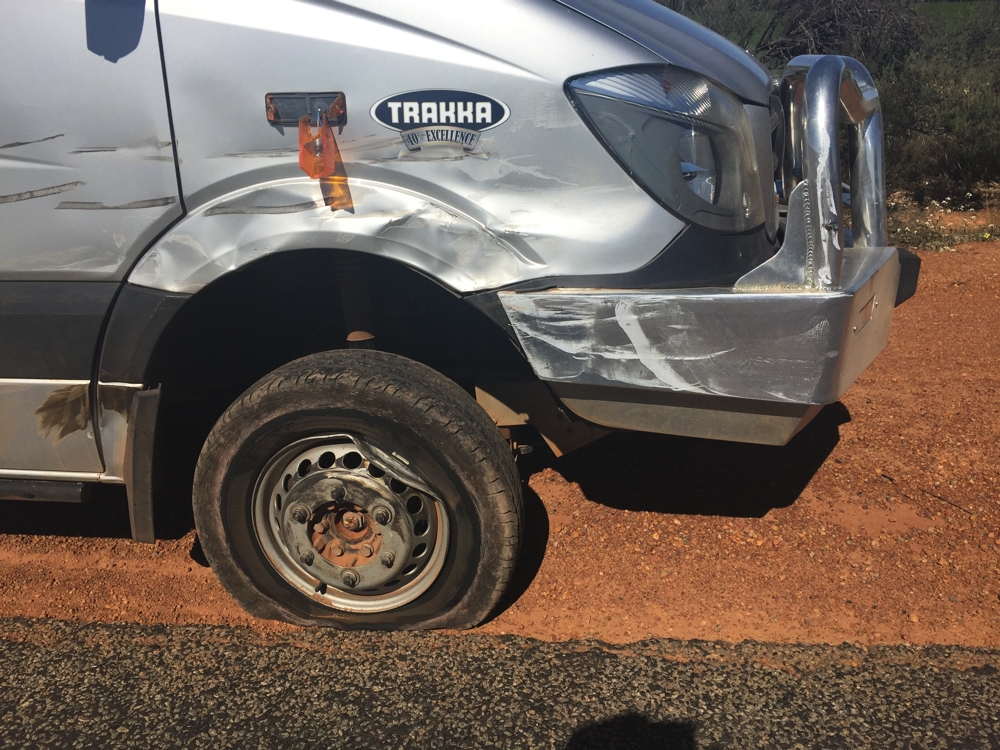5th – 15th September, 2017
Western Australia has more than 12,000 species of wildflowers with more than 60% of them being unique to WA. The wildflower season is a big draw card for tourists and scientists annually. The timing of the rain and sunshine influences the timing of the season with it beginning in the north as early as June (we were seeing wildflowers in the Pilbara in June), extending through to November in the south. They cover an area of around 2.5 million square kilometres.
Our plan for the next few weeks is to wander around the central western section working our way gradually back towards Perth.
Tuesday 5th
A lazy day today, not leaving our lovely quiet beachside campsite until lunchtime. Farewelling the very windy Shark Bay we begin the inland part of our wildflower journey.
Butchers Track is an ‘alternative’ route from the coastal highway to the inland, ie it’s a dirt road – not too bad though, just a few corrugations and it’s lovely to once again see the deep red strip of earth unfolding before us between the olive green of the surrounding acacias.
Tonight we’ve pulled off Butchers Track down a service road to camp. Despite the lovely warm temperature, lack of wind, clear skies and full moon we had an unpleasant sundowners outside beset by clouds of midgies (sandflies).

Having just exited Butchers Track we’re heading to Wooleen Station.
Wednesday 6th
Our little home was midgie-proof allowing us to sleep well – and very peacefully. No traffic overnight, not surprising as we only saw two vehicles during our drive. Brunch at the Murchison Roadhouse (in our motorhome) then on to Wooleen Station to camp ($20/n unpwred).
This Station stay had been recommended to us by several people as not only a pleasant place to stay, but also an example of a young couple who were trying to farm sustainably. A rural TV report has been done on the work they are doing.
Wooleen Station covers about 300,000 acres of mostly mulga, saltbush and blue bush grazing land. It had been heavily stocked with sheep. In the mid 1930s a combination of a long and severe drought and 27,000 sheep eating everything they could see (17000 of them died of starvation), caused the destruction of the land and nearly totally wiped out the perennial vegetation needed to protect the soil and provide food during the dry summer months when annuals died.
Surveys done in the 1990’s revealed 80% of the vegetation to be in less than ‘good’ condition, with the remaining good vegetation being in rocky areas where grazing animals (sheep, cattle, kangaroos and feral goats) can’t reach.
Enter Dave Pollock and Frances Jones. Dave’s parents bought the property in 1989. Dave and Frances destocked the property for 4 years to help the vegetation recover. Since then they have only lightly stocked during good seasons and planned stock rotation and landcare carefully.
An interesting aside is that several years ago they had thousands of kangaroos and so many feral goats they were rounding them up and selling them, all a problem for their regeneration and negating the effect of their destocking. Enter the dingoes! The dingoes have wiped out the feral goats, while the kangaroo population and the feral cat population is under control. Bringing balance back into the ecology.
Dave took us and about 10 other people on a 3 hour tour of the property ($45ea) pointing out the degraded areas to compare with the regenerating areas. A long way to go still, but great to see what they have achieved so far.

Boodra, on Wooleen Station and our little tour bus.
We finished the tour at the Boodra Rocks where there’s a cave with a fresh water spring. Truly beautiful rocks and a lovely spot where we had wine and nibbles as the sun sank behind the cloud cover (I think it did – it was overcast).

Boodra, on Wooleen Station. A fresh water spring is underneath that collection of rocks, the entrance via a cave where those people are standing.
Thursday 7th
Despite Dave being convinced the few drops of rain we’d had on our tour yesterday would be the last rains for September, it started raining about 3am and didn’t stop until late afternoon today. Not heavily but enough to close all the roads around here, 50mm.
We spent a very quiet day camped beside our Gidgee Tree, the only campers at this site which is about 6km from the homestead. There are two other camping areas, one 16km the other 17km from the homestead.
Friday 8th
We couldn’t leave Wooleen today until the Council opened one road allowing us to leave – “But drive slowly!”
Tonight we camped at Mullewa Caravan Park, which was booked out – we got the last site! We needed to be here tonight to get internet for Steve to watch the Broncos match.
Saturday 9th
Leaving Mullewa we headed east to go through Pindar and up to see the famous wreath flowers. They were beautiful.

From here south we really enjoyed the wildflowers growing by the roadside.

Camping tonight is at Canna. This tiny town provides a free camp (donation box) with lovely clean hot showers and loos. There’s even 4 power points to plug into for those who need it. Well done and thank you Canna.

There’s a lot of these ‘scenes’ made in various historical sites around these small outback towns. It’s lovely to see them.
Sunday, Monday 10-11 th
A short drive today to Three Springs camp – another great little campsite with good facilities for the cost of a donation.

These lovely town signs are at the entrance to each town on the Wildflower Trails.
We took a walk around the town, did a little shopping, particularly from the highly recommended butcher, followed the Heritage Trail to learn may about the town and enjoyed a restful couple of nights.

This bush is just all flowers.
Tuesday 12th
On to Latham tonight. A great little sporting complex with a community building with hot, clean showers and pretty flowers in all the gardens. Once again, well done Latham.

Wednesday 13th
Should have known by the date that today wouldn’t be that good! Driving happily along though narrow country roads on our way to stay with our friends Terry and Christine in Dowerin, when SMACK – hit by a ute that was passing the car and caravan that had started to pass us. Luckily no one was hurt, though the ute was a write-off and Priscilla is going to need some extensive panel-beating, but fortunately is still drivable.

This kinda upset our day.
Thursday, Friday 14th – 15th
Restful couple of days, mostly spent doing admin – claim forms for insurance! We also had fun with Terry and Christine catching up on our various travels and family doings. Dowerin is a small town in the wheat belt that has a lovely community feel, all being involved in the State-wide-famous Dowerin Field Day.

Rusty the Tin Dog, the HInchcliffs and us at Dowerin.
Saturday 16th
Leaving Dowerin we headed toward Perth via Meckering and Northam.
At 10.59a.m. on the 14th October 1968, the small town of Meckering was destroyed by an earthquake. Twenty people were injured. The magnitude of the Meckering earthquake was 6.9 on the Richter Scale, but relatively shallow at 7km deep, making it one of the largest recorded in the seismic history of Australia. The largest land displacement measured a westward heave of 2.44m, a southerly slip of 1.5m and vertical lift of 1.96m. In the park is a section of the rail lines with a big S- bend in them and a section of the water pipe that concertinaed together. Amazing forces.

In the Earthquake Memorial park are a few items to demonstrate the power of the earthquake. These railway lines are one, another a portion of a water pipeline that had intussusception.
We enjoyed brunch at Northam in a lovely cafe overlooking the river before heading on to Mt Lawley to spend the weekend with Ann and Greg (yet to retire, hence the weekend).
For more photos of this time in our travels CLICK HERE.